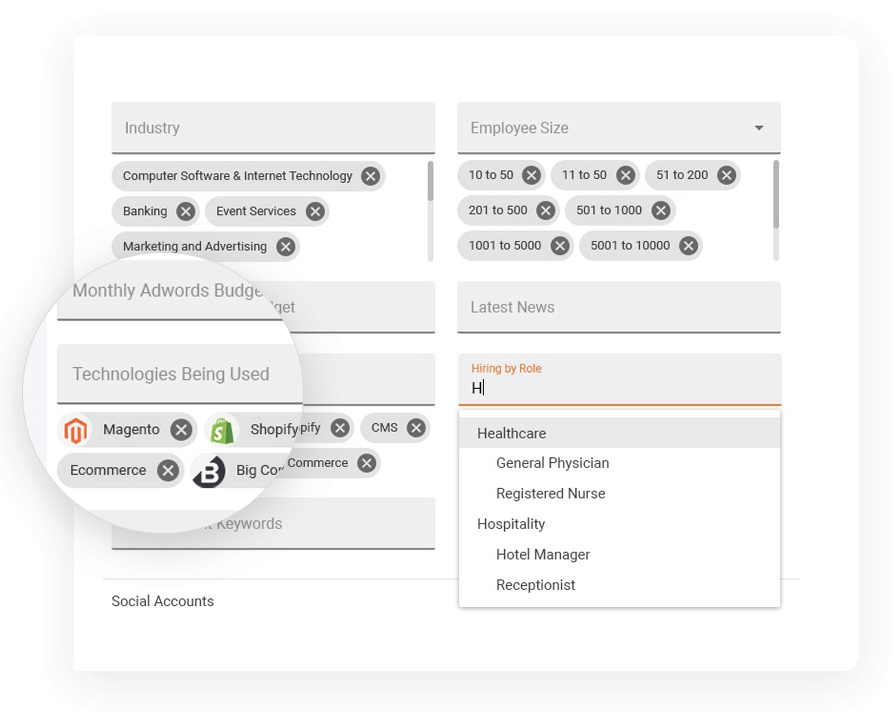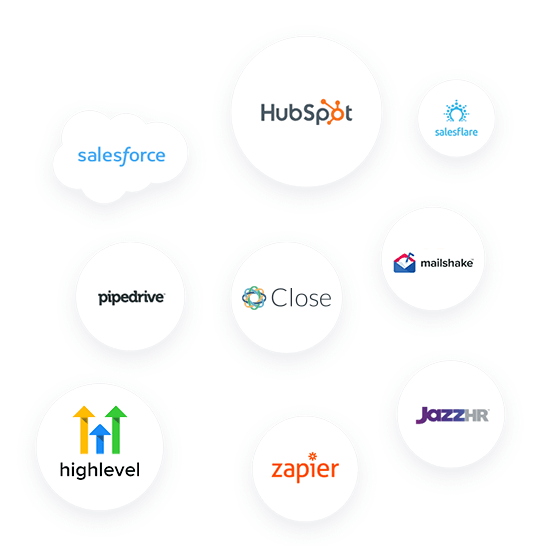

LeadFuze is a consistent quarterly winner in the Lead Intelligence category, with top ratings for ease-of-use (9.0), quality of support (9.3), and ease-of-setup (9.0).








LeadFuze is a consistent quarterly winner in the Lead Intelligence category, with top ratings for ease-of-use (9.0), quality of support (9.3), and ease-of-setup (9.0).






"LeadFuze has made it easy for me to build prospecting lists to reach out to via LinkedIn, cold email, and telephone. This saves 10+ hours per week of manual list-building."






"I use it to build highly targeted lists that are automatically added to our CRM and mailing system. It is a huge time saver as the leads can be paced over time."





Salespeople love that we provide hyper-targeted lead searches and provide actual contact data. Not to mention complete list building automation so they spend more time talking to prospects vs researching them.
Sales teams love using our integrations with their CRM and workflow tools along with de-duplication of leads.
See the Sales Use Case
Marketers love that we provide personal emails as well as business emails so you can have higher match rates for custom audience ad targeting and building outreach lists for their sales team.
Marketing agencies love using LeadFuze to build lead lists for their clients as an easy add-on solution to their offerings.
See the Marketing Use Case
Recruiters love that we provide both personal and company emails and filtering by people who do not have an active job. Use it as a passive sourcing tool to find people who are not actively looking for a job!
Staffing agencies love using the hiring filter and getting their contact info and automatically getting new leads matching that criteria.
See the Recruiting Use Case
Imagine wanting to get emails, phone numbers, and social profiles for everyone that...
Is a CEO anywhere in the world within the Computer Software vertical with 11+ employees that also spends $1k/mo on Adwords who is hiring for marketing help and who just recently announced an integration partnership.
With LeadFuze, you can run searches like this. Go as deep or as broad as you want!


Imagine wanting to get emails, phone numbers, and social profiles for:
LeadFuze makes it possible to get contact information for these people.
LeadFuze's proprietary system does all the heavy lifting for you. No need to use a third party validation service because we already do it for you. Use the Ignore List and you won't have to scrub your list, worry about adding existing customers or competitors.
You can put your list building on autopilot, then sit back as Fuzebot, our A.I. assistant, will automatically add new leads he finds in the future that match your criteria. He can also drip them into your CRM or workflow tools to automatically trigger outreach campaigns.
Avoid adding your existing contacts, competitors, or customers.
Avoid adding leads you, or other team members, have already added.
Get double verified emails, performed in real-time, for 0% bounce rates. No need for your own list cleaner!
Let Fuzebot build your lists for you and add new leads he finds that match that criteria.
Get double verified emails, validated in real-time for a 0% bounce rate.
Scale up your cold calling efforts with phone numbers for your targeted leads.
Use Fuzebot, our AI assistant, to keep building lists for you over time.
Get LinkedIn, Facebook, and even Twitter profiles for multi-channel social selling.
Get full insights on your leads including work history, skills, college education, and more.
Get personal + company emails to build custom audiences on social networks.
Use our integrations to trigger multi-channel outreach campaigns.
Qualify leads based on their monthly Adwords spend.
Expand your current customer accounts or find new ones.
Find all employees within an organization and get their contact info.
Find companies hiring for specific roles. Even search by keywords.
Filter by companies who are raising funds or even investing in others.
Find companies who have recently announced new partnerships, integrations, etc.
Find companies who have recently hired key executives, fired key employees, or made key promotions.
Find companies who have recently expanded product lines, opened new offices, and more.
Find companies who use specific technologies.
Find candidates with specific skills to match with current job openings.
Take your data with you. Export to CSV or Google Sheets.
LeadFuze integrates with popular CRM’s and ATS's so you don’t have to manually add all the data yourself.
Connect with outreach tools and social automation systems to trigger workflows, completely hands-free!
You can also use Zapier and connect to 1,000+ tools.
In addition to our integrations, you can export LeadFuze lead data at any time to CSV or Google Sheets.

Or, if you're interested in accessing the full database, contact us.
With the LeadFuze API, you'll be able to enrich your existing email marketing database, your job applicants, your trial signups, leads in your CRM, and more.
You can even run your own searches and pull in results directly in your own app.
Request Early API Access
Enrich personal profiles using email or LinkedIn profile URL and get complete details like contact info, job history, skills, education, and more.
Enrich company details using Company name or URL and get complete details like contact info, technologies, job openings, ad budget, company news, and more.
Our People Prospector API will allow you to find leads in bulk the same way our current app allows you to find leads using our Market Based Search. No other API exists in this way!
Our Company Prospector API will allow you to find specific companies in the same way our Account Based search function works. Again, no other API exists in this way!
If you are a current customer, you can pull data out of your current LeadFuze lists into third party apps.

Discover what are attributes of a good leader that inspire success and foster strong teams. Unlock the secrets to effective leadership now! …
CONTINUE READING
Explore key factors influencing economic growth as we unpack what might lead to an expansion in the business cycle, driving prosperity. …
CONTINUE READING
Discover why employees seek remote work for better balance and expanded career opportunities. Dive into the flexibility that’s reshaping today’s workforce! …
CONTINUE READINGLeadFuze was established in 2014 and our team is distributed throughout the globe, with headquarters just outside of Phoenix, Arizona.
Business Professionals
Companies
Users
Going wide to support a large audience and a wide array of use cases, while going deep enough to be usable, all the while keeping data accurate is a LOT of work.
We spend six figures each year on data partnerships and our own web and social site crawling. This gives us nearly 1.8 billion people profiles! We are able to repeat this process through the entire 1.8 billion profiles every quarter, while looking for more profiles to add to our lead pool.
We match all individuals with their corresponding companies, further enrich with company related details like latest news, jobs, technologies, ad spend, and more. We trash all of the junk profiles which are not useful. This gets us down to about 950 million unique profiles.
The magic happens in our verification. Our proprietary validation system leads to the highest deliverability possible. Through this process, we cut down our usable profiles to just over 500 million records and only then are they added to our lead pool.
Computer Software - SaaS
"I don't have to hire VA's anymore for the cumbersome task of creating lists through scraping various channels. The problem with VA's can be that it's difficult to gauge the quality of their leads. Whereas with LeadFuze lead generation is now like a breeze. I especially love the ultra targeting ability where I can play around with various filters to reach a specific market segment or a company account."

Marketing & Advertising
"Doing business outreach, LeadFuze has become my go-to on almost a daily basis. Its ability to provide a wide spectrum of results and more importantly, reliable and accurate - makes it a must-have."

Human Resources
"LeadFuze is a great source of leads for outbound email. Quick and easy to set up. Great tool for quickly generating a list of targets."

Insurance
"We are a small insurance agency and we use LeadFuze to find highly targeted for our prospects for our sales efforts. I am the primary user at this point and use it to build highly targeted lists that are automatically added to our CRM and mailing system. It is a huge time saver as the leads can be paced over time."

Digital Marketing Agency
"I really like the 'no nonsense' interface and simplicity of LeadFuze. As a digital marketing agency, I also really like the AdWords budget filter... This is great! I can target prospects who are already spending at least 'X' amount of money on paid ads, so I have a basic idea of their budget before I even approach them."

Marketing & Advertising
"We use LeadFuze to build lead lists quickly and automate our lead generation process. It has helped us save a tremendous amount of time searching for potential customers' data. We use LeadFuze across the entire organization."

Marketing & Advertising
"LeadFuze is being used by our sales department to generate new leads on autopilot. It's most useful for us as a small business to be able to "set and forget" our prospecting efforts. Everything is easy to use and the price point is great. No complaints so far with using LeadFuze!"

E-Learning
"Our entire organization uses this tool to locate leads. The tool helps us in locating potential new customers that are interested in our online and onsite customized training for business analysis, project management, lean six sigma, Agile, and leadership."

Computer Software - SaaS
"We're currently using LeadFuze to prospect leads then push them into our CRM for marketing or sales follow ups and so far the experience has been fantastic. The solution itself is very easy to use and the support for the product is unlike any other company that I have worked with. I would highly recommend this product to anyone looking to automate their prospecting process."

Non-Profit
"We use LeadFuze to generate leads for the organization for marketing purposes (events, trade missions, trade shows). LeadFuze helps us find new targets and be able to contact them quickly and efficiently."

Management Consulting
"I am using LeadFuze to generate leads for the whole company. We are a B2B sales coaching and recruitment company and we are often looking for decision makers to connect with. This is incredibly hard to do manually but LeadFuze has the capabilities to reduce my daily grind."

Real Estate
"We are using it to help us not only reach out to other real estate investors on LinkedIn to help us move assets and attract funding for deals, we are also using it with our podcast to help book guest spots and speaking opportunities on other podcasts to help get the word out as well."

Marketing & Advertising
"We are using it to gather prospects for our lead generation. It solves the problem of not having contact information for our target avatar."

Education Management
"Getting our business in front of the right people has always been challenging and expensive. PPC worked well for many years, but it is now more expensive and not as effective. Email marketing and LeadFuze has allowed us to target our email campaigns to the proper audience. It is cost effective and we are seeing good results. LeadFuze is easy to use and to show others how to use it. LeadFuze is an important piece of our growth plan over the next three years."

And the list goes on and on... and on... 20,000+ users can't be wrong. We recommend seeing it for yourself :)